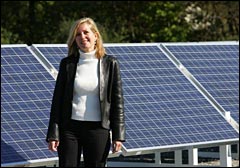
This city was once the shoemaking capital of the Northeast, and over the years it was home to boxers Rocky Marciano and Marvin Hagler, earning it the nickname “City of Champions.” Today, however, Brockton, Mass., holds the dubious honor of being one of the region’s trash capitals, because of its high concentration of waste-disposal and recycling facilities.
And you wouldn’t want your kids playing in what’s left of the open spaces in this hardscrabble urban area halfway between Boston and Providence. Some of Brockton’s remaining parcels are EPA-designated brownfield sites, useless for homes and playgrounds because of the toxic substances left behind by coal-burning plants, leatherworks, and textile factories.
Waste and recycling contractors are among the traditional bidders for those sites. But Brockton appears to be sick of taking everybody else’s garbage. Rather than convert its remaining brownfields into tire recycling plants or tow lots, the city this week introduced the nation’s largest “brightfield” — a 3.7-acre lot filled with 1,395 solar panels arranged in neat, long rows. The panels are rooted in busted-up rocks that cover the coal tar and ash from a 19th-century gasworks facility. Amidst the old industrial buildings that comprise much of Brockton’s Ward Four, they almost appear to be of alien origin.
Organizers hope the brightfield project will help clean up Brockton’s grubby reputation and show that it can be an innovative provider of renewable energy. “We want people to know that if you’re proposing to use these sites for all of your trash uses, we had something else in mind,” says Lori Ribeiro, who has been a brownfields consultant to Brockton since 2000.
Federal government officials and local pols also hope the brightfield will show the public they are serious about renewable energy, even as New England continues to set new daily records for peak electricity demands, according to the U.S. EPA.
But the project also illustrates that local communities and states are driving the development of large-scale renewable projects, says Alan Nogee, director of the clean-energy program at the Union of Concerned Scientists. “The federal government is lagging far behind in support for these projects,” he says.
The $3 million Brockton Brightfield was funded jointly by the city, a public-and-private-sector partnership called the Massachusetts Technology Collaborative, and the U.S. Department of Energy, which pitched in $789,000.
Nice Day for a Bright Feting
The only cloud in the sky at a ribbon-cutting ceremony Thursday came from a metal foundry adjacent to the site — a fitting start for a project that many admitted will have only a slight impact on the region’s growing appetite for electricity. By providing enough juice for about 71 homes annually, the brightfield will earn Brockton about $130,000 each year. The city will sell the electricity it generates to a Baltimore, Md.-based supplier, Constellation NewEnergy. Brightfield organizers estimate the solar plant will take up to 20 years to recoup its costs.
But the Brockton Brightfield will show that New England is embracing renewables, said Warren Leon, director of MTC’s Renewable Energy Trust, which contributed $1 million to the project. “It is a visible symbol of that momentum [toward renewable energy],” he said. “It will encourage additional developments.” Brockton is also home to Johnson Square Village, a new solar-powered condo development, and even the city’s high school has a small solar system on its roof.
In general, though, New Englanders seem somewhat ambivalent toward renewable energy. While leading Massachusetts gubernatorial candidate Deval Patrick supports Cape Wind, a massive wind farm proposed for Nantucket Sound, many local landowners oppose the project, a private enterprise to be built on public property.
Even some Brockton locals — they are a meat-and-potatoes lot with accents as thick as any you’ll hear in Boston — were wary of the brightfield proposal. They worried that the project would create an annoying reflective glare in their windows, or that high-voltage power lines would crisscross overhead, adding insult to an already bleak view from the front porch of any home abutting the site. Speaking at the ribbon cutting, Brockton City Council Rep. Linda Balzotti recalled her initial reaction when she heard the proposal from a brightfield organizer: “I thought he had rocks in his head.”

Lori Ribeiro spins brown into gold.
But organizers quickly won residents over with the site’s neatly landscaped design and low-profile, shoulder-high 300-watt solar panels, which were manufactured locally, by SCHOTT Solar in Billerica, Mass. Ribeiro, the city’s brownfields consultant, hopes the site — which the city plans to extend to another brownfield parcel directly across the street — will become a destination for school trips and other educational events.
Meanwhile, Nogee of UCS says federal backing for local developments such as the Brockton Brightfield is likely to continue, but at the expense of other, more immediately promising renewable technologies. The Bush administration has proposed increasing the federal budget for solar energy technology to $148 million. But the budget also calls for the zeroing out of all funding for promising geothermal and hydropower technologies.
And that, as Nogee says, is “not the way to go about the development of renewable energy across the board.”



